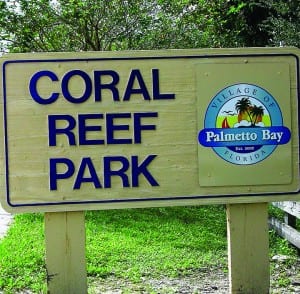
Coral Reef Park.
Two resolutions that had been deferred from the Palmetto Bay Council’s Feb. 25 special meeting regarding changes to Coral Reef Park and Palmetto Bay Park came up for a vote during the Mar. 4 session.
The changes for Coral Reef Park, 7895 SW 152 St., would include two new batting cages to replace old ones, replacement of the sports lighting system at the tennis center and bench sitting areas with shade canopies at the tennis center. During the public hearing portion of the meeting about a dozen residents came forward to speak, virtually all of them in favor of the tennis improvements.
“My son has been playing tennis and takes lessons three nights a week at Coral Reef Park,” said Gail Dembro. “My husband plays two nights a week but he drives further to Continental Park because of the superior lighting. Sometimes he has to go to Coral Reef Park as a last resort, but the lighting is inadequate. I hope that the changes can be made.”
Michael Gordon, an area student, agreed about the lighting problem.
“The lighting is terrible,” Gordon said. “Even going from Court 2 to Court 1 the lighting is much worse on Court 2. During the day there is no shade. They have umbrellas but they don’t even put them up. There are benches missing. I play tennis for my high school tennis team and the court surfaces there are better than they are at Coral Reef. I support all the renovations.”
Although council members seemed to agree that the tennis lighting was bad, there were questions raised by Vice Mayor John DuBois and Councilmembers Tim Schaffer and Patrick Fiore about costs, the type of lighting and the batting cages.
DuBois also was concerned about changing the parks master plan, although village attorney Eve Boutsis and village Planning and Zoning director Darby Delsalle explained that a resolution by the village council in 2004 required such a change for any modifications to the parks. Much of the council discussion was devoted to expressing differing viewpoints on that issue.
“By changing the use from residential to government use zoned we are taking the zoning requirements of residential property, which it is currently zoned, which is subject to neighborhood protection ordinance outside of the scope that we’re no longer on the same footing and have the same set of requirements as private schools and churches, and I am certainly not in favor of that,” DuBois said. “I think we need to correct our Neighborhood Protection Ordinance to allow private schools and churches to be on the same footing.”
Councilmember Joan Lindsay pointed out that every private school has a public hearing at which time a resolution is drawn up and site specific conditions applied, things that couldn’t be changed by the vote on the park.
“Right now, the churches and schools have something the parks don’t have,” Lindsay said. “It’s not the other way around. The park has had lights for over 20 years. If the lights at the park go down we don’t have the site plan. There is no master plan for the schools. There is a site plan for each school that was brought forward when they brought an application forward and received a development resolution with conditions. We don’t have that process for government parks.”
After considerable additional debate and a false start with the voting process that required a super-majority for that issue, the resolution in both parts for Coral Reef Park passed unanimously.
There also was support from the public and the council for planned improvements to Palmetto Bay Park. The fate of the skatepark was another matter.
In public comments, Gary Pastorel said, “I support the changes except for the conversion of the skatepark to the soccer field. Young people can play soccer just about anywhere, as long as there’s grass and such.”
Buster Trocene spoke again in favor of the skatepark, but Sheila Fraser raised questions about liability and behavior by the skateboard users.
Eric Tolberg said, “Lastly, for the skatepark, that was a free tennis court at one time that was very popular. It was made into the skatepark, and now a few years later we’re going to convert it again. We should really not change things around so often.”
David Singer spoke in favor of leaving the skatepark as it is, but Marsha Matson said, “The skatepark, I understand, is a nuisance. I would like to hear staff report on the police that have been called out and the problems with grafitti. I think that minisoccer fields would be a good idea.”
When it came time for council discussion, Tim Shaffer had a question for Parks and Recreation director Fanny Carmona- Gonzalez: “In reference to demolishing the skatepark — first of all, why?”
“The skatepark has been open since ’06,” Carmona-Gonzalez said. “We’ve had to replace the fence three to four times that I can recall from the time that I’ve been here. It gets minimum use, not maximizing the potential use of that site. It requires one permanent staff standing at that gate at all times, over 52 hours a week, to man that area. Because of the required helmet wearing and the rules that we have in place, we have to have that staff standing there, for only that purpose. And again, with three kids using that skatepark and one person standing there, it’s not getting its maximum use.
Mayor Shelley Stanczyk expressed concerns over vandalism at the skatepark and store break-ins nearby.
Due to divided opinions among the council members and the fact that staff did not have cost information on the fence replacements and other maintenance, a decision on the skatepark was deferred until the May council meeting to allow for fact gathering and more public input at an April Committee of the Whole (COW) meeting.






